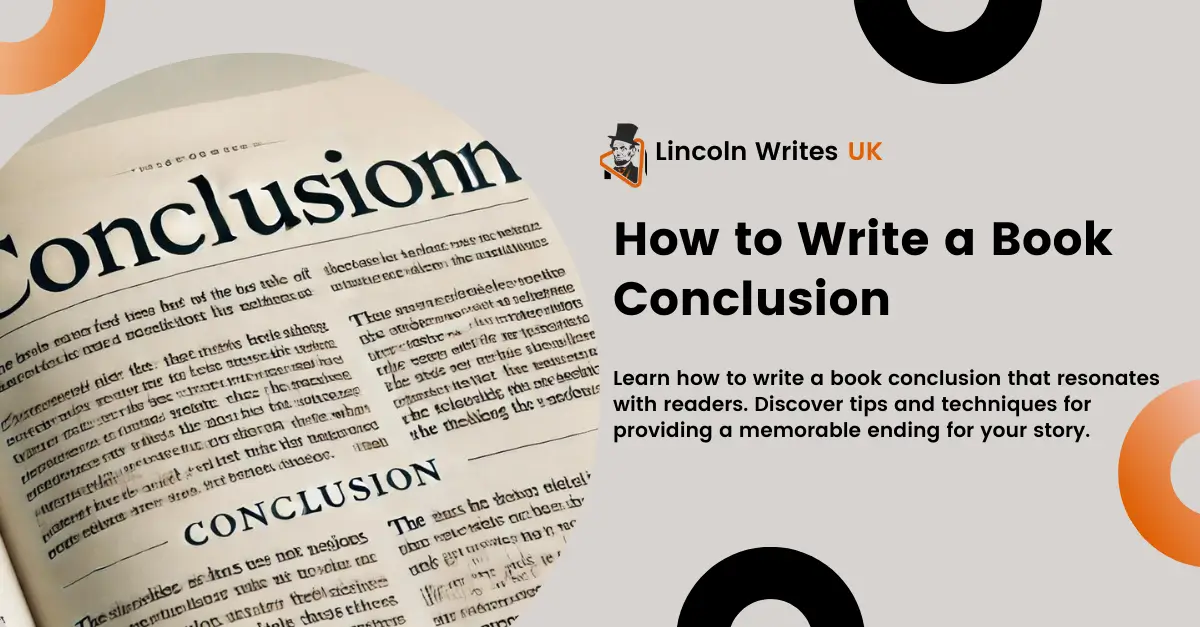Every great story needs a powerful conclusion. It is the final touch that leaves a lasting impression on readers. How to write a book conclusion is a skill that every author should master, as it ensures that the narrative is wrapped up in a satisfying manner. A well-written conclusion not only ties up loose ends but also reinforces the themes and messages of the story, providing readers with a sense of closure and fulfillment. In this blog, we will explore the significance of a book conclusion and provide practical tips on how to create an impactful ending for your story.
Understanding the Purpose of a Book Conclusion
A book conclusion serves several crucial purposes in the storytelling process. First and foremost, it provides closure. After investing time and emotions into the story and its characters, readers expect a resolution that addresses the main plot points and answers any lingering questions. This sense of closure is essential for reader satisfaction and helps prevent the feeling of being left in the lurch.
Furthermore, a strong conclusion reinforces the book’s themes and messages. It is an opportunity for the author to underline the key takeaways and ensure that the central ideas resonate with the reader. By doing so, the conclusion enhances the overall impact of the story and leaves a lasting impression.
Another important aspect of a book conclusion is its ability to evoke emotions. Whether it’s joy, sadness, relief, or surprise, a well-crafted ending can evoke a powerful emotional response. This emotional connection is what often makes a story memorable and encourages readers to recommend it to others.
In summary, understanding why book conclusion is important in book writing helps authors appreciate the critical role it plays in reader satisfaction, thematic reinforcement, and emotional impact. A thoughtfully constructed conclusion can elevate a good book to greatness, ensuring that it lingers in the minds and hearts of readers long after they have turned the final page.
General Guidelines : How Long Should a Conclusion Be?
Determining how long should a conclusion be is a common question among authors. While there is no one-size-fits-all answer, there are some general guidelines that can help. Typically, a book conclusion should be long enough to wrap up the story satisfactorily without dragging on unnecessarily. A good rule of thumb is to aim for a conclusion that is proportionate to the length and complexity of the book. For a shorter novel, a conclusion of one to two chapters may suffice, whereas a longer, more intricate story might require a more extended ending.
Factors That Influence the Length
Several factors can influence the length of a book conclusion:
- Genre: Different genres have varying expectations for conclusions. For example, mystery and thriller novels often have concise, punchy endings that resolve the central conflict quickly, while literary fiction may have more elaborate conclusions that reflect on the story’s themes and characters.
- Complexity of the Story: A story with multiple subplots and intricate character arcs will typically need a longer conclusion to address all the loose ends adequately. On the other hand, a more straightforward narrative can afford a shorter, more direct ending.
- Pacing: The pacing of the conclusion should match the rest of the book. A fast-paced novel should not suddenly slow down in the final chapters, and a leisurely-paced book should not rush to its conclusion.
Ultimately, how long should a conclusion be depends on the unique needs of your story. The key is to ensure that the ending feels complete and satisfying without overstaying its welcome.
Overview of Different Types of Book Endings
There are several different types of book endings that authors can use to conclude their stories, each with its own strengths and potential drawbacks. Here are some common types:
Resolved Ending: This type of ending provides a clear resolution to the main conflict, tying up all the loose ends. It leaves little to no ambiguity, giving readers a sense of closure.in J.K. Rowling’s “Harry Potter and the Deathly Hallows,” the story concludes with the defeat of Voldemort and an epilogue showing the characters’ lives years later.
Cliffhanger Ending: A cliffhanger leaves the story unresolved, creating suspense and anticipation for a sequel. This type of ending can be frustrating for some readers but is effective in keeping them engaged for future installments. Suzanne Collins’ “The Hunger Games: Catching Fire” ends with Katniss being rescued from the arena, but with many questions left unanswered about the fate of her allies and the rebellion.
Ambiguous Ending: An ambiguous ending leaves certain aspects of the story open to interpretation, allowing readers to draw their own conclusions. This can provoke thought and discussion, but it can also leave some readers feeling unsatisfied. In F. Scott Fitzgerald’s “The Great Gatsby,” the novel ends with Nick reflecting on Gatsby’s life and the American Dream, leaving the ultimate meaning of Gatsby’s story up to the reader.
Twist Ending: A twist ending introduces an unexpected turn of events that changes the reader’s understanding of the story. It can be shocking and memorable if executed well. In Agatha Christie’s “And Then There Were None,” the twist reveals the mastermind behind the murders in a surprising and clever way.
Understanding the different types of book ending and examples can help authors choose the best book conclusion for their story, ensuring a memorable and impactful ending.
Steps to Writing an Effective Book Conclusion
Essential steps to write a compelling conclusion that resonates with readers. From recapping the main themes to resolving conflicts and ensuring emotional impact, these steps ensure your conclusion leaves a lasting impression.
1. Recap the Main Points or Themes of the Book
An effective conclusion begins with a recap of the main points or themes of the book. This reminder helps reinforce the key messages you want your readers to take away. Summarize the journey the characters have gone through, the challenges they faced, and how they overcame them. This not only ties the narrative together but also highlights the growth and development that occurred throughout the story.
2. Resolve Any Remaining Conflicts or Storylines
One of the most critical steps in writing a conclusion is to resolve any remaining conflicts or storylines. Readers invest in the characters and plot, and they expect a payoff for their investment. Make sure to address all the subplots and tie up any loose ends. This doesn’t mean every question needs a definitive answer, but the primary conflicts should reach a resolution that feels satisfying.
3. Leave Readers with a Final Thought or Emotional Impact
The conclusion is your last chance to leave an impression on your readers. Aim to leave them with a final thought or emotional impact that resonates. This could be a poignant reflection, a powerful statement, or a memorable scene that encapsulates the essence of the book. The goal is to evoke a strong emotional response, whether it’s joy, sadness, hope, or contemplation, ensuring your story lingers in their minds.
4. Tips on Ensuring the Conclusion Aligns with the Book’s Overall Tone and Message
Consistency is key in a conclusion. Ensure that the tone and message of your ending align with the rest of the book. If your story has been light-hearted and humorous, a suddenly dark or somber ending might feel jarring. Conversely, if your book tackles serious themes, a flippant ending might undermine its impact. Revisit the themes and tone established throughout the book and make sure your conclusion complements them. This creates a cohesive and satisfying reading experience.
Common Mistakes to Avoid
The three critical errors to avoid when writing your book’s ending are Rushing the ending, which risks leaving readers dissatisfied, and introducing new conflicts or characters, which can disrupt the narrative flow.
1. Rushing the Ending
One of the most common mistakes authors make is rushing the ending. After investing so much time and effort into the bulk of the book, it can be tempting to wrap things up quickly. However, a rushed conclusion can leave readers feeling unsatisfied and cheated. Take the time to develop your ending thoughtfully, giving it the attention it deserves to ensure it is as impactful as the rest of your story.
2. Introducing New Conflicts or Characters
Another pitfall to avoid is introducing new conflicts or characters in the conclusion. This can confuse readers and disrupt the flow of the story. The conclusion should focus on resolving existing storylines and conflicts, not complicating the narrative further. New elements introduced at this stage can feel out of place and detract from the overall cohesion of the book.
3. Leaving Too Many Loose Ends
While some ambiguity can be intriguing, leaving too many loose ends can frustrate readers. Ensure that the main plot points and character arcs are resolved in a satisfying manner. Unresolved storylines can make the conclusion feel incomplete and leave readers with more questions than answers. Strive for a balance that ties up the essential elements of the story while leaving room for thought and interpretation.
Final Tips and Best Practices
This is essential guidance for refining your conclusion to achieve maximum impact. From revising for flow and clarity to seeking feedback from beta readers or editors, these steps ensure your conclusion is polished and resonant.
1. Revising and Refining the Conclusion
Once you’ve written your conclusion, it’s important to revise and refine it to ensure it effectively ties up your story. Pay attention to the flow, clarity, and emotional impact. Read it multiple times, and consider the pacing—ensure it neither rushes nor drags. Look for opportunities to strengthen the language, eliminate unnecessary details, and enhance the overall coherence of the conclusion.
2. Getting Feedback from Beta Readers or Editors
Feedback is invaluable when perfecting your book conclusion. Share it with beta readers or professional editors who can provide an unbiased perspective. They can highlight any weaknesses, inconsistencies, or elements that may not resonate with readers. Constructive criticism will help you identify areas for improvement and ensure your conclusion meets readers’ expectations.
3. Ensuring Consistency with the Rest of the Book
Consistency is crucial in crafting a satisfying conclusion. Revisit the themes, tone, and character development established throughout the book. Ensure that your ending aligns with these elements, providing a cohesive and harmonious finish. Consistency will make your conclusion feel like a natural and fitting end to the story, enhancing the overall reading experience.
Wrapping up:
A compelling conclusion is essential for leaving a lasting impression on your readers. By understanding how to write a conclusion for a book, you can effectively recap the main points, resolve conflicts, and leave readers with a powerful final thought or emotional impact. Ensure your conclusion aligns with the book’s overall tone and message, avoiding common pitfalls like rushing the ending or introducing new conflicts.
By applying these tips and best practices, you can create a satisfying and memorable ending that resonates with your audience, reinforcing the importance of a well crafted book conclusion in book writing.
Frequently Asked Questions
The length of a conclusion should be proportionate to the length and complexity of your book. For shorter novels, a concise conclusion of one to two chapters is often sufficient. Longer, more intricate stories may require a more extended ending to address all plot points. Remember, how long a conclusion should be is ultimately dictated by the needs of your story.
Introducing new characters or conflicts in the conclusion is generally not advisable. The conclusion should focus on resolving existing storylines and conflicts. New elements can disrupt the flow and confuse readers. Stick to wrapping up the main plot points to ensure a satisfying ending.
To ensure consistency, revisit the themes, tone, and character development established throughout your book. Make sure your conclusion reflects these elements and provides a cohesive finish. Consistency is key to creating a conclusion that feels like a natural extension of the story, enhancing the overall reading experience.


